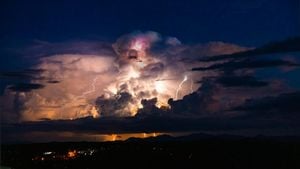The conflict between Ukraine and Russia continues to dominate headlines as the United States reaffirms its commitment to support Ukraine. This geopolitical crisis, which began nearly two years ago with Russia’s unlawful annexation of Crimea and subsequent aggression, has drawn sharp responses from Western nations. The stakes are incredibly high, not just for the immediate region but also for global stability.
On the battlefield, Ukrainian forces remain engaged against Russian military units, facing both conventional troops and increasingly sophisticated technology. According to reports, American assistance has been pivotal. The U.S. has sent billions of dollars worth of military aid, including advanced weaponry, training resources, and intelligence support. This influx of U.S. resources helps fortify Ukraine’s defenses as it seeks to repel the Russian onslaught.
Recently, President Joe Biden announced additional military support, responding to requests from Ukrainian officials. This support is not simply about the quantity of equipment but also the quality. The inclusion of cutting-edge weaponry, such as precision-guided missiles and advanced drone systems, aims to level the playing field and give Ukrainian forces the tools they need for effective resistance.
The motivations behind U.S. support are layered. Strategically, the U.S. sees Ukraine as a bulwark against Russian expansionism. A successful Ukrainian defense is perceived as key to preventing Russia from gaining ground, thereby weakening its influence and intimidating other former Soviet states.
There’s also a moral dimension to this involvement. Many Americans have expressed solidarity with the Ukrainian people, who continue to endure tremendous hardship amid this conflict. Images of civilians enduring bombings, schools transformed to shelters, and families torn apart have turned public sentiment firmly against Russian aggression. Non-profit organizations have mobilized to provide humanitarian assistance, and the public's donations and support reflect solidarity with the Ukrainian struggle for freedom and sovereignty.
Analysis of recent economic data shows how sanctions against Russia have begun to bite, significantly affecting its economy. The Russian government faces mounting pressure, evidenced by reports of declining GDP, inflation rates nearing 20%, and credit downgrades. This economic strife, coupled with military setbacks, is causing waves of anxiety within Russia. There are growing fears among Russian citizens related to the long-term sustainability of the war effort.
Domestically, U.S. lawmakers are largely united across party lines on the necessity of supporting Ukraine. This bipartisan consensus stems from the recognition of the broader threat posed by Russia to democratic values globally. The willingness to fund military assistance has at times wavered due to concerns over budget allocations and priorities, but so far, the overall trend has favored increased aid.
Despite this support, challenges remain. Ukrainian officials have warned about the risks of fatigue—both at home and abroad—regarding prolonged involvement. While they receive arms, there are questions about the sustainability of this assistance as the conflict drags on. Proposals for negotiations between Russia and Ukraine have surfaced, but they often run up against hardline positions from both sides. The Russian government, for its part, seems disinterested in compromise, which complicates peace efforts.
Looking more broadly, NATO’s approach to the crisis is pivotal. The alliance has fortified its eastern flank with troops and equipment, signaling its commitment to deterrence. Countries like Poland and the Baltic states have been vocal proponents of continued support for Ukraine, fearing they could be next if Russian ambitions are left unchecked.
Meanwhile, European nations have also moved to support Ukraine—though some have expressed hesitations due to their dependence on Russian energy supplies. This has spurred debates about energy independence and the need for diversified sources to prevent blackmail from Russia.
The humanitarian crisis resulting from the conflict is staggering. Millions of people have been displaced, with estimates indicating over 7 million people are internally displaced due to the war. Neighboring countries, particularly Poland, have received large influxes of refugees seeking safety. International organizations are striving to provide aid, highlighting the immediate human need for food, medical care, and shelter as casualties mount.
A recent report by the United Nations indicates there have been significant civilian casualties since the conflict reignited. Hospitals are overwhelmed, and humanitarian corridors established to deliver aid face bomb threats and aggression, complicity the situation even more. The images and stories from the ground serve as grim reminders of the stakes involved.
So, what does the future hold? Analysts are divided. Some believe the current momentum indicates Russia might seek to deepen its engagement or escalate operations through more severe tactics. Others speculate the internal pressures within Russia could lead to some re-evaluations of their tactics, especially as the economic toll becomes harder to bear.
While discussions of diplomacies surface intermittently, they often lack traction. A setback for both Russian and Ukrainian forces might open the door for talks, but the stance of President Vladimir Putin remains unclear, and his public statements have consistently espoused hardline views. Meanwhile, President Zelenskyy of Ukraine has consistently communicated the necessity of territorial sovereignty and has indicated his commitment to regain lost land.
The challenge is multifaceted; it involves not only military strategies but also emotional and psychological endurance. Ukrainian resolve remains strong, but how long this can be sustained amid mounting casualties and economic destruction is yet to be seen.
Global opinions on the intervention reveal another layer of complexity to the situation. While Western nations predominantly support Ukraine, others play their cards close to their chests, maintaining relationships with Russia. Nations with significant trade ties to Moscow face tough decisions—whether to engage or distance themselves from Russia amid the geopolitical storm.
Back at home, public discourse focuses on the cost of U.S. involvement; discussions swirl about how much more should be committed and how the resources used might affect domestic issues. The U.S. assists here, balancing priorities and helping internationally all under the layer of increasing awareness of global interdependence.
The upcoming months will be pivotal. Military strategies, humanitarian needs, and the geopolitical chessboard are ever-evolving dynamics. With each passing day, new developments emerge, bringing shifts not only within Ukraine but across Europe and beyond.



